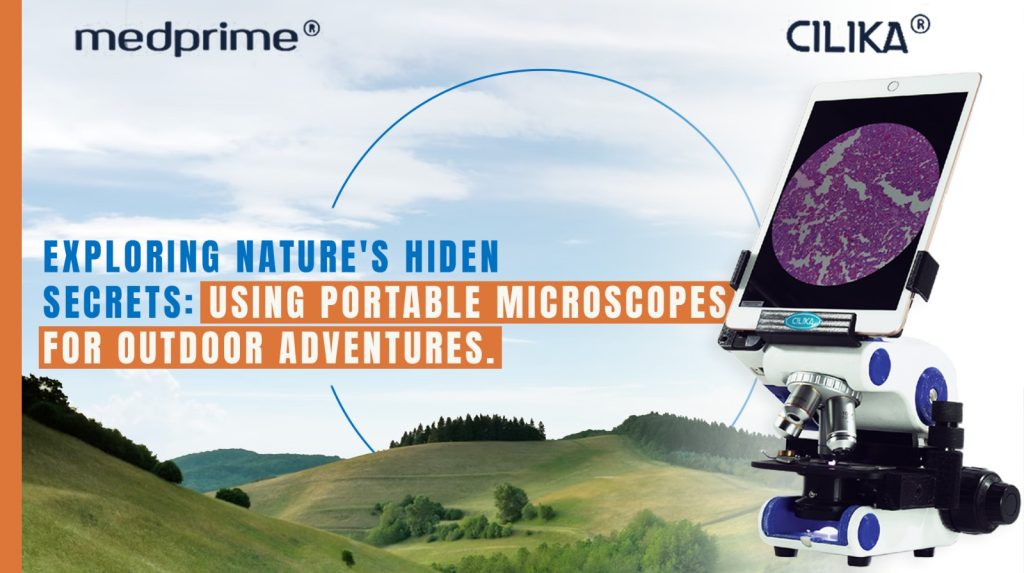Gone are those days when students or researchers used to painstakingly gather samples and wait to examine them in their lab under a microscope. While fetching samples could still involve a herculean effort, portable microscopes have revolutionized microscopy. Students or researchers can now carry these microscopes with them to the research site and view a sample under the microscope at the very next moment!
But what are portable microscopes? And what role do they play in helping researchers and students explore nature’s hidden secrets? Let’s see.
What are Portable Microscopes?
Portable microscopes are compact and lightweight microscopes. They allow easy transportation. Hence, researchers and students can use them to examine samples in remote locations. Some of their applications include education, quality control, and field research, where their portability plays a significant role.
Portable microscopes are available in various types. They include handheld pocket microscopes, mobile microscopes, and portable compound microscopes.
Handheld microscopes – paper based microscopes such as Foldscope – pls elaborate
Mobile microscopes – Combination of optical system with camera of mobile phone for imaging that converts your mobile phone into a microscope. Varieties range from single lens systems with low magnification of ~100X to high magnification systems such as Cilika.
Portable compound microscope – Traditional monocular or binocular microscope, but in a compact, lightweight structure.
Portable Microscope Features
Portable microscopes offer various features that drive their use and significance in the field of microscopy. Let’s look at some of the most essential features.
- Battery powered
Portable microscopes are battery-powered. Hence you can carry them for field visits, seminars, conferences, and lectures and work in remote areas without electricity.
- Real time imaging and analysis – no loss of time in transporting sample to lab, imaging can be done onsite
- Variety of magnifications to choose from – ranging from single ball lens systems that provide ~100X magnification to Cilika portable microscopes that can give upto 1500X, you have a wide range of imaging systems to choose from that will best suit your project.
Choosing the Right Portable Microscope
Portable microscopes prove an undoubtedly beneficial device. But you can optimize its benefits only when you choose the right one.
Factors influencing the choice of a microscope include image size, magnification, screen, sensor, lighting source, and network interface. Primarily for digital microscopes, look at the sensor’s number of pixels, the magnification rate, the screen size (whether it meets your requirements), the number of LED lights for the lighting source, the network interface’s Wi-Fi function support, and if it can capture photos, record, and measure. Most importantly, a portable microscope should have a robust build that does not get damaged during transport. It should not require realignment before each use as this can be difficult to achieve on field.
Observing Plant Life with a Portable Microscope
Portable microscopes are highly useful in observing plant life. Here are some benefits.
- Cell Structure
Observers can see cell structures within the plant. Higher magnification allows them to view complex structures that conduct functions critical to a plant’s lifecycle.
- Plant Reproduction
Various advancements in microscopy, including portable digital microscopes, enable researchers to observe the plant’s reproductive process as it happens. It can help them save endangered species and propagate advantageous species of plants.
- Ecological Impact
A plant may apparently look healthy. But at the cellular level, it could be damaged due to environmental elements. Microscopic observation can help scientists identify an early warning alerting concerning potential food supply hazards.
- Plant Diseases
Botanists can observe and identify plant diseases via microscopes. They can identify the source of a plant’s distress and foster early intervention to treat the cause or protect the neighboring plants from the pathogen’s spread.
Inspiring Curiosity Within Students with a Tablet Microscope
Students are curious individuals. But their endeavor to learn demands infrastructural support. When it comes to exploring nature’s hidden secrets, portable microscopes or tablet microscopes can help add value to their outdoor venture. These microscopes allow them to view samples under the microscope instantly and thus fuel their urge to learn and explore more.
CILIKA Portable Microscopes, with their numerous features, can prove a valuable asset whether you are a school or a research lab. With their ergonomic design, TrueView technology, digital data storage and sharing, and compact size, these microscopes are already revolutionizing the field of microscopy and will continue to build value.
Click to learn more about CILIKA Portable Microscope or email Medprime at contact@medprimetech.com to learn more about the microscopes.
